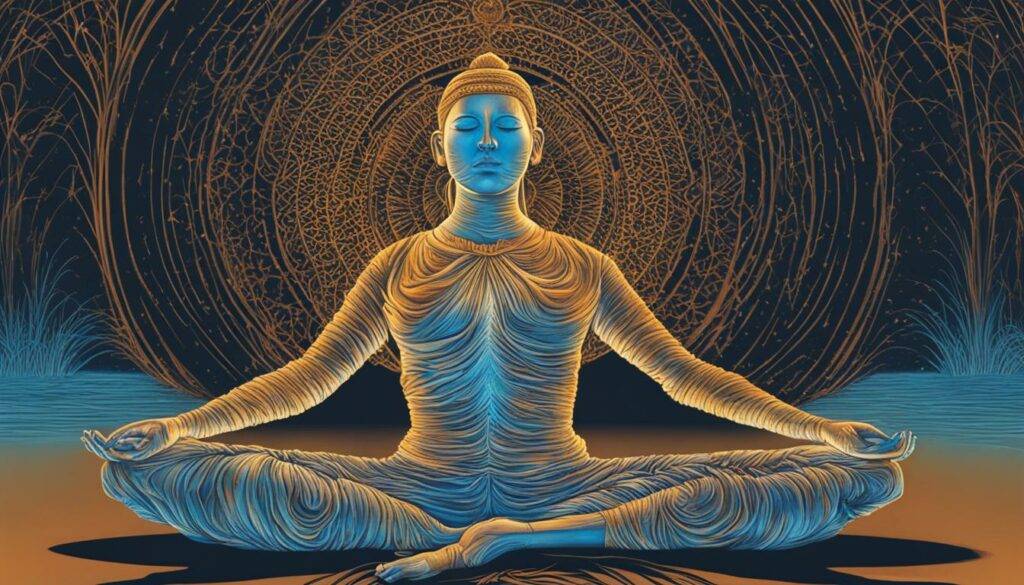Welcome to the world of Brahmari Pranayama, also known as the bee breath. This powerful breathing technique offers a simple yet effective way to calm the mind and find relief from the daily stresses of life.
By practicing this technique, you can tap into a sense of inner peace and tranquility, allowing yourself to unwind and rejuvenate.
When practicing Brahmari Pranayama, you will create a humming sound during the exhalation, mimicking the gentle and soothing buzz of a bee. This sound becomes a vehicle for releasing tension and promoting a deep sense of relaxation.
With its ability to harness the power of your breath, Brahmari Pranayama can be practiced anywhere, anytime, making it a convenient tool in your journey towards well-being.
Regular practice of Brahmari Pranayama can offer numerous benefits. It aids in improving concentration, reducing blood pressure, and providing relief from headaches and throat ailments.
It is a practice that not only nurtures your mind, but also promotes overall physical and emotional well-being.
If you are ready to embark on the path of tranquility and peace, let’s explore how to practice Brahmari Pranayama and uncover its amazing benefits.
Key Takeaways:
- Brahmari Pranayama, or the bee breath, is a simple and powerful technique for calming the mind and finding relief from stress and anxiety.
- By making a humming sound during exhalation, this practice helps release tension and promotes relaxation.
- Brahmari Pranayama can be practiced anywhere and at any time, providing a convenient tool for managing daily stress.
- Regular practice of Brahmari Pranayama can lead to improved concentration, reduced blood pressure, and relief from headaches and throat ailments.
- Start your journey towards well-being and inner peace with the soothing and transformative power of Brahmari Pranayama.
How to Practice Brahmari Pranayama
To practice brahmari pranayama, follow these simple steps:
- Find a comfortable seated position with a straight back.
- Gently close your eyes and place your index fingers on the cartilage between your cheek and ear.
- Take a deep breath in.
- As you exhale, make a humming sound like a bee, gently pressing the cartilage.
- You can make a high-pitched or low-pitched sound, depending on your preference.
- Inhale again and continue the same pattern for five to nine breaths.
- Afterward, keep your eyes closed and observe the sensations in your body.
- You can practice brahmari pranayama three to nine times every day for maximum benefit.
Remember, the key is to find a relaxed, comfortable position and focus on your breath as you make the buzzing sound. By practicing brahmari pranayama regularly, you can experience its calming and soothing effects on the mind and body.
Benefits of Brahmari Pranayama
Brahmari pranayama offers a wide range of benefits for both the mind and body. Here are some of the advantages:
- Promotes relaxation and reduces stress and anxiety.
- Improves concentration and focus.
- Helps lower blood pressure and reduce the risk of heart disease.
- Relieves tension and headaches.
- Aids in throat ailments and respiratory conditions.
Regular practice of brahmari pranayama can bring about a sense of calm and clarity, enhancing your overall well-being.
Variations of Brahmari Pranayama
In addition to the basic steps outlined above, there are variations of brahmari pranayama that you can explore:
| Variation | Description |
|---|---|
| Shanmukhi Mudra | A hand position involving placing thumbs on the ear cartilage, index fingers on the eyes, middle fingers on the nostrils, ring fingers above the upper lip, and little fingers below the lower lip. |
| Forehead Variation | A hand position involving placing thumbs on the ear cartilage, index fingers on the forehead above the eyebrows, middle fingers on the eyes, ring fingers on the nostrils, and pinky fingers next to the corners of the lips. |
Exploring these variations can add depth to your practice and enhance the benefits of brahmari pranayama.

Next, we’ll discuss the precautions and contraindications to keep in mind while practicing brahmari pranayama.
Benefits of Brahmari Pranayama
The benefits of brahmari pranayama are numerous. This powerful breathing technique provides instant relief from tension, anger, and anxiety, helping to calm and soothe the mind.
Brahmari pranayama is particularly effective in reducing throat ailments such as sore throat and inflammation. The humming sound created during the practice helps to clear the respiratory passages, promoting better respiratory health.
If you suffer from migraines or experience slight headaches, incorporating brahmari pranayama into your routine can bring relief.
The deep breaths and humming vibrations help to alleviate headache symptoms and provide a sense of calm.
Regular practice of brahmari pranayama has been shown to improve concentration and memory.
By focusing on the breath and the humming sound, the mind becomes more focused and alert, leading to enhanced cognitive function.
In addition, this breathing technique is beneficial for reducing blood pressure. The slow, controlled breaths and the calming effect on the nervous system help to lower blood pressure levels, promoting overall cardiovascular health.
Brahmari pranayama is a valuable tool for stress relief, providing a sense of relaxation and calmness. By combining the breathwork with the humming sound, you can release tension and find inner peace.

| Benefits of Brahmari Pranayama | Keywords |
|---|---|
| Instant relief from tension, anger, and anxiety | brahmari pranayama for stress relief, brahmari pranayama for anxiety |
| Reduces throat ailments | importance of brahmari pranayama |
| Relieves migraines and slight headaches | brahmari pranayama for relaxation |
| Improves concentration and memory | importance of brahmari pranayama |
| Helps in reducing blood pressure | brahmari pranayama for stress relief |
| Promotes stress relief and relaxation | brahmari pranayama for relaxation |
Variations of Brahmari Pranayama
There are variations of brahmari pranayama that can enhance the experience. One variation involves practicing the technique while holding a hand position called Shanmukhi mudra.
This involves placing the thumbs on the ear cartilage, index fingers on the eyes, middle fingers on the nostrils, ring fingers above the upper lip, and little fingers below the lower lip.
Another variation includes placing the thumbs on the ear cartilage, index fingers on the forehead above the eyebrows, middle fingers on the eyes, ring fingers on the nostrils, and pinky fingers next to the corners of the lips.
Precautions and Contraindications
When practicing brahmari pranayama, it is essential to follow certain precautions to ensure a safe and effective practice. Here are some key precautions to keep in mind:
- Press the cartilage gently: Place your index fingers on the cartilage between your cheek and ear, but make sure not to insert them inside the ear. Apply gentle pressure to activate the desired acupressure points.
- Maintain moderate pressure: Avoid pressing the cartilage too hard, as excessive pressure can cause discomfort or pain. Remember to find a balance that feels comfortable and allows for a smooth practice.
- Keep your mouth closed: During the humming sound in brahmari pranayama, it is important to keep your mouth closed. This allows the sound vibrations to resonate within your nasal cavity, enhancing the benefits of the practice.
- Practice on an empty stomach: To maximize the benefits of brahmari pranayama, it is recommended to practice on an empty stomach. Wait at least two hours after having a meal before engaging in this breathing technique.
Contraindications
While brahmari pranayama can be beneficial for many, there are certain contraindications to consider. Individuals with the following conditions should avoid practicing brahmari pranayama:
- Menstruating or pregnant women: Due to the potential impact on the reproductive system, it is advisable for menstruating or pregnant women to refrain from practicing brahmari pranayama.
- Extremely high blood pressure: The breath-holding and pressure applied during brahmari pranayama can temporarily increase blood pressure. Therefore, individuals with extremely high blood pressure should avoid this practice.
- Epilepsy: As brahmari pranayama involves breath retention, individuals with epilepsy or a history of seizures should avoid this breathing technique.
- Chest pain: If you experience chest pain or any cardiac discomfort, it is important to consult with a healthcare professional before attempting brahmari pranayama.
- Active ear infection: If you have an active ear infection or any condition affecting your ears, including ear surgery or injury, it is best to avoid brahmari pranayama. The pressure and vibrations may exacerbate the condition.
Remember to listen to your body and consult with a healthcare professional if you have any concerns or underlying health conditions before beginning a new breathing practice like brahmari pranayama.
| Precautions | Contraindications |
|---|---|
| Press cartilage gently Maintain moderate pressure Keep mouth closed Practice on an empty stomach |
Menstruating or pregnant women Extremely high blood pressure Epilepsy Chest pain Active ear infection |
Conclusion
Brahmari Pranayama, also known as the bee breath, is a powerful technique that can bring calmness to your mind, reduce stress, and promote relaxation. By incorporating this simple yet effective breathing exercise into your daily routine, you can experience instant relief from tension and anxiety.
Following the steps and variations mentioned in this article, you can make the most of brahmari pranayama and enjoy its numerous benefits. However, it is essential to take precautions and be aware of any contraindications before practicing this technique.
Once you have familiarized yourself with the proper techniques and precautions, you can incorporate brahmari pranayama into your daily life.
By making it a regular part of your routine, you can tap into the soothing and transformative power of the bee breath, allowing for a harmonious balance of mind, body, and spirit.
FAQ
What is Brahmari Pranayama?
Brahmari Pranayama, also known as the bee breath, is a breathing technique that involves making a humming sound during exhalation. It is used to calm the mind, find relief from stress and anxiety, and promote relaxation.
How do I practice Brahmari Pranayama?
To practice Brahmari Pranayama, find a comfortable seated position with a straight back. Gently close your eyes and place your index fingers on the cartilage between your cheek and ear.
Take a deep breath in and, as you exhale, make a humming sound like a bee, gently pressing the cartilage. Inhale again and repeat this pattern for five to nine breaths, observing the sensations in your body afterward.
What are the benefits of Brahmari Pranayama?
Brahmari Pranayama provides instant relief from tension, anger, and anxiety. It helps calm an agitated mind, reduces throat ailments, and can be beneficial for those experiencing migraines or slight headaches.
Regular practice improves concentration, memory, and confidence, as well as reduces blood pressure. It promotes stress relief, relaxation, and a sense of inner peace.
Are there variations of Brahmari Pranayama?
Yes, there are variations of Brahmari Pranayama that can enhance the experience. One variation involves practicing the technique while holding a hand position called Shanmukhi mudra.
Another variation includes placing the thumbs on the ear cartilage, index fingers on the forehead above the eyebrows, middle fingers on the eyes, ring fingers on the nostrils, and pinky fingers next to the corners of the lips.
What precautions should I take while practicing Brahmari Pranayama?
It is important to press the cartilage gently and avoid putting your finger inside the ear. Do not press the cartilage too hard and keep your mouth closed while making the humming sound.
It is recommended to practice Brahmari Pranayama on an empty stomach. However, avoid practicing it if you are menstruating or pregnant, have extremely high blood pressure, epilepsy, chest pain, or an active ear infection. Avoid practicing Brahmari Pranayama while lying down.
What is the conclusion about Brahmari Pranayama?
Brahmari Pranayama, or bee breath, is a simple and effective technique for calming the mind, reducing stress, and promoting relaxation. By following the steps mentioned and incorporating variations, you can experience its numerous benefits.
However, it is important to take precautions and be aware of contraindications before practicing Brahmari Pranayama.




























































